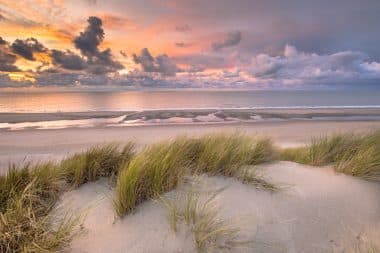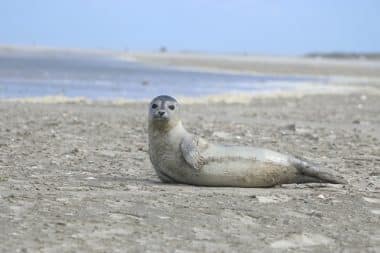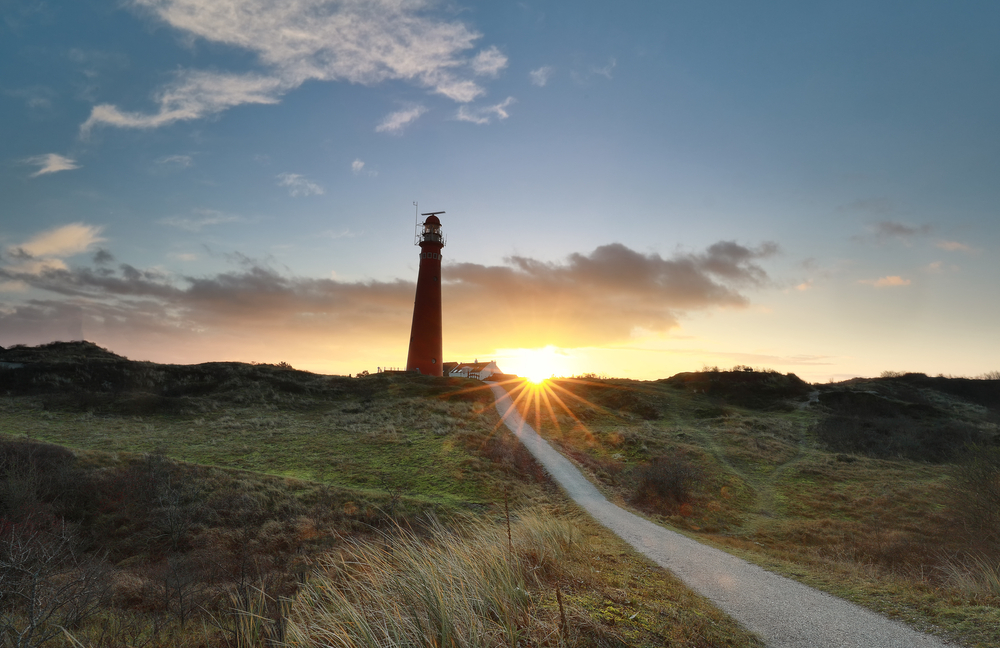Switch off and take a deep breath. If you like deserted islands, this is the place for you. The West Frisian island of Schiermonnikoog is not remote, but it is original. Their nature is untamed, and it is not overcrowded. “Little tuft” is what the Dutch affectionately call the island with the unique dune landscape. Fans rave that it offers the most beautiful sunsets. If you stand on a dune, you can enjoy the view of the roaring sea or the coastline off Groningen. The Dutch island between the North Sea and the Wadden Sea is located west of Borkum – in between there are only uninhabited bird islands. Schiermonnikoog is not only a resting place for migratory birds, but also a refuge for stressed people who are looking to slow down with wind in their hair and mudflats under their bare feet – to “come down”.
Schiermonnikoog means “Island of the Grey Monks”
Parties? Nothing. Instead, miles of white wide beaches. The widest measures almost a kilometre. In contrast to other islands, Schiermannikoog grows, even migrates, because sand is constantly washed ashore, and the wind does the rest. 16 kilometers long and four kilometers wide is the smallest of the West Frisian islands. Some consider it the most beautiful in the Netherlands. It got its strange name because Cistercian monks in gray robes once lived there. “Schiermonnikoog” means “island of the grey monks” in West Frisian dialect.
Cars are not allowed on the most beautiful island in the Netherlands
Today, it mainly invites visitors to endless walks and cycling. But that’s not all. The tourist infrastructure is right, because the bathing culture has a long tradition on Schiermonnikoog. Pretty guesthouses, comfortable and worth seeing historic (!) Hotels, a campsite and chic holiday apartments provide the variety of accommodations. Pretty bric-a-brac shops line the main street. Tourists also do not have to do without culinary delights in cafés, pubs and restaurants. There are dignified fish restaurants next to a beach pavilion in the dunes, which invites you to a sundowner. Only cars are not allowed on the island. However, an exception is made for the approximately 1000 “natives”.
Quaint brick houses and hotels from the 18th century

Westerburen was once the name of the island village that was swallowed up by the sea. The new island village of Schiermonnikoog further west, carefully planned on the drawing board, is also old. At least it has retained a lot of monument worthy of monument status. After all, there are still buildings from the 18th century. The small Dutch brick houses – some with stepped gables facing the street “Lange Streek” – look very quaint. Large concrete blocks of all kinds – whether shopping centres, new hotels or apartment complexes – are sought in vain. In the 70s, the island council prevented a construction boom. That is the big plus of Schiermonnikoog today. The island was declared a national park in 1989 – flora and fauna are to be protected. 300 bird species have been counted on Schiermonnikoog.
Sailing across the sandy beach in a three-wheeled buggy
Although the island is so small, there are forests, lakes, salt and dry meadows, polders, cows and the impressive mudflats. In addition to waterfowl, pheasants strut through the tall grass, and rabbits flit across the dunes. Hobby ornithologists get their money’s worth. Visitors can enjoy the pure nature, which is not so harmless: at high tide, many meadows are flooded, and sometimes hikers are trapped until the low tide frees them again. Hang-gliding, kiting or sailing with the three-wheeled buggy over the sandy beach are unforgettable holiday experiences. A small shell museum is also waiting for tourists.
Schiermonnikoog’s lighthouses are a popular photo motif
The island’s attractions also include two beautiful old, architecturally elegant lighthouses, which unfortunately are not allowed to be visited. But they are a welcome photo motif. The white Zuidertoren (south tower) is 31 metres high and, like its twin building, dates from 1854. It has lost its old function, was a water tower in the meantime and is now a broadcasting tower. However, the red Noordertoren (north tower) is still in operation. It has since been modernised and continues to make it easier for ships to pass through the shallows off Schiermonnikoog. Admittedly, it can get crowded on the island in July and August. Then up to 4000 visitors land on Schiermonnikoog every day. The tourist information and the two Fietsen rental stations, where tourists can rent bikes and tandems, are then besieged. The positive thing about the rush of day visitors: By the last ferry to Lauwersoog at the latest, they have disappeared again in the evening. By the way, the crossing from this ferry port to the island takes 45 Minuten.In Lauwersoog, visitors can park their cars in the parking garage during their flying visit.
As early as 1866, the Fisherman’s Island became the “Schiermonnikoog Resort”

A German plays a major role in the history of the island. But first, John Eric Banck from The Hague bought the island in 1859. As it became increasingly difficult for the island’s fishermen and sailors to make a living from their work, Banck came up with the idea of opening up the island for tourism. He organized the ferry service to Groningen, set up a room rental business and had a beach pavilion built. Schiermonnikoog was declared a “seaside resort” as early as 1866. By the way, the clever businessman loved his small bench for a rest on the dike – the “Bank von Banck” still exists today. In 1893, Banck sold the island again – to the German Count Berthold Hartwig Arthur von Bernstorff-Wehningen. In 1927, he built the first jetty, today’s marina. The landowner, who died in 1987, also had roads built and coniferous forest planted. During World War II, he protected the island from Nazi attacks. Even today, he enjoys great prestige on Schiermonnikoog.
Können wir Ihnen helfen?
Benötigen Sie Unterstützung bei Ihrer Reiseplanung oder weitergehende Informationen zu einzelnen Reisezielen? Wir freuen uns über Ihre Kontaktaufnahme.


